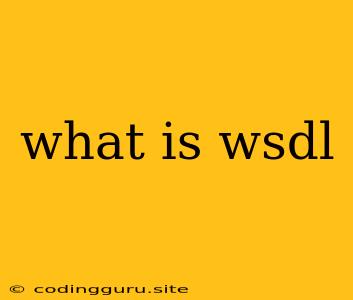What is WSDL?
WSDL, which stands for Web Services Description Language, is an XML-based language used to describe the interfaces and data types of web services. It acts as a blueprint for web services, providing a standardized way to define and publish their functionalities, allowing applications to discover, understand, and interact with them effectively.
Why is WSDL Important?
WSDL plays a crucial role in making web services interoperable and accessible. It enables:
- Service Discovery: WSDL files can be used by clients to discover available web services and their capabilities.
- Service Understanding: WSDL provides a clear definition of the service's interface, including the operations it supports, the data types it uses, and the communication protocols it employs.
- Service Integration: Developers can use WSDL to automatically generate code for interacting with web services, simplifying integration and development efforts.
How Does WSDL Work?
A WSDL document typically consists of several sections:
- Definitions: Defines namespaces, types, and message structures used in the service.
- Types: Defines the data types used in the service, including complex types and simple types.
- Messages: Defines the data structures exchanged between the client and the server.
- PortTypes: Defines the operations supported by the service, their input and output parameters, and the communication protocol used.
- Bindings: Defines the specific communication protocol and transport mechanism used by the service.
- Service: Describes the actual service endpoint, providing the address where the service can be accessed.
Example of WSDL
This WSDL defines a simple weather service that allows clients to retrieve weather data for a specific city. The document defines the data types, messages, operations, and bindings used by the service, allowing clients to understand and interact with it.
Advantages of Using WSDL
- Standardization: WSDL provides a well-defined and standardized way to describe web services, promoting interoperability and compatibility.
- Discoverability: WSDL files can be easily published and accessed, making it easier for clients to discover and use web services.
- Automation: WSDL enables the automatic generation of code for interacting with web services, simplifying integration and development efforts.
- Loose Coupling: WSDL promotes loose coupling between clients and services, allowing them to evolve independently.
Disadvantages of Using WSDL
- Complexity: WSDL can be complex to write and understand, especially for developers who are not familiar with XML.
- Overhead: Generating and parsing WSDL files can add overhead to the communication process.
- Limited Flexibility: WSDL is primarily designed for SOAP-based web services, limiting its use with other protocols like REST.
Conclusion
WSDL is a valuable tool for describing and publishing web services, promoting interoperability and simplifying service integration. While it has some drawbacks, its advantages in standardization, discoverability, and automation make it a valuable resource for developers working with web services.
